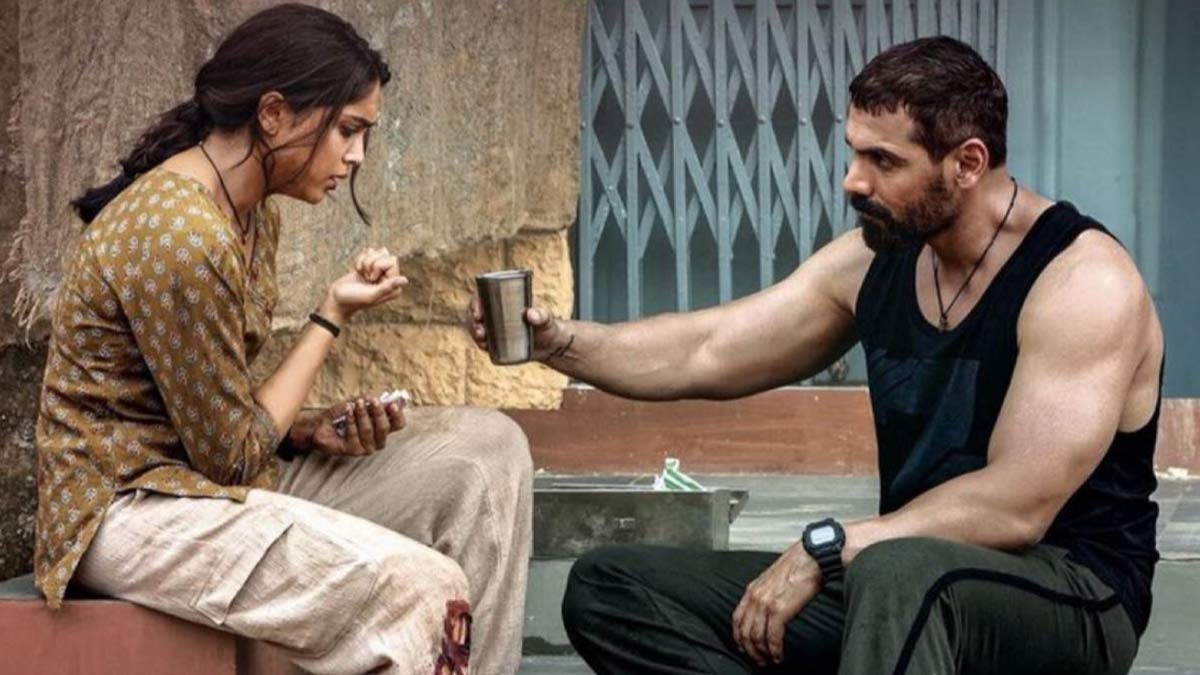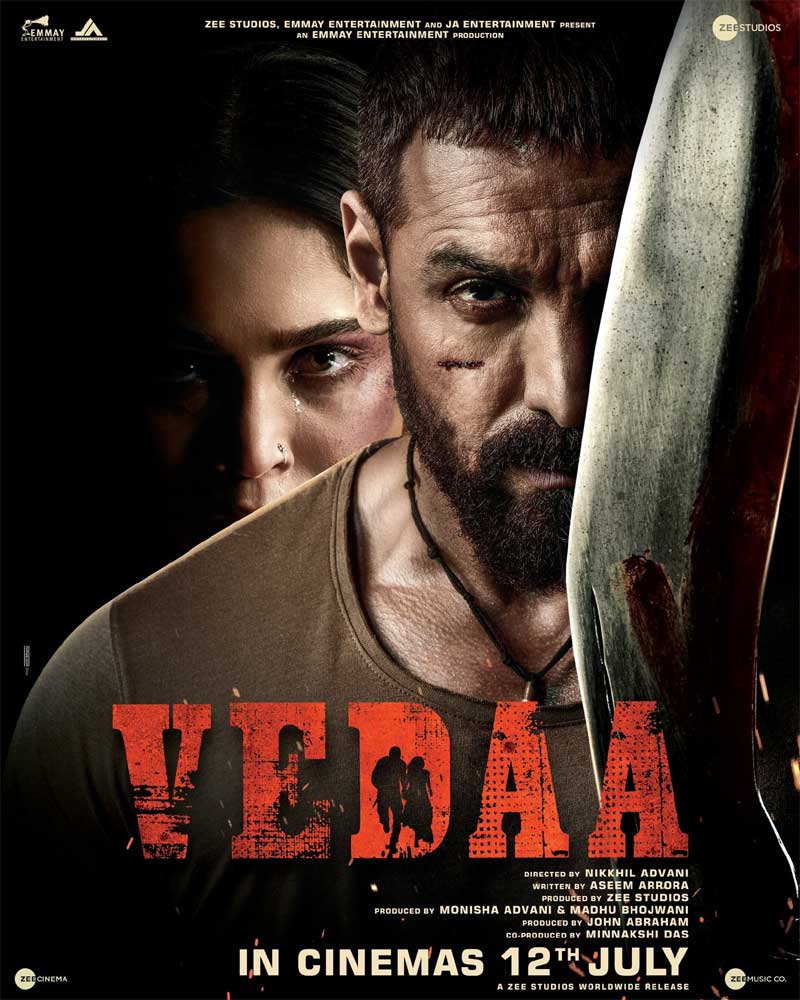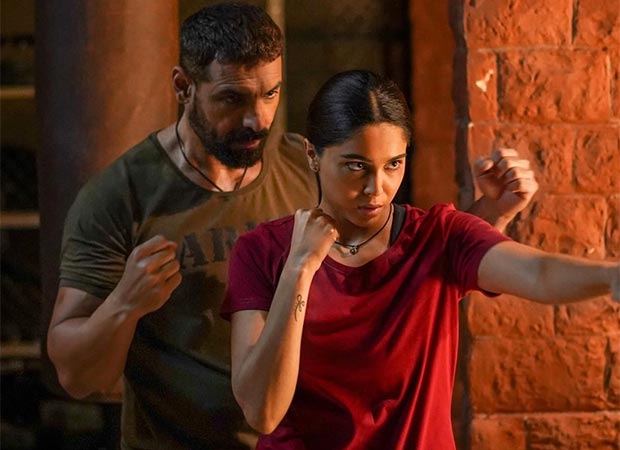The most challenging proposition that a Bollywood film can make is questioning the age-old gender norms and giving the central light of bravery and ferocity to its female protagonist. While it is an appraising feat that Nikhil Kamath’s recent film Vedaa attempts to achieve, as it tries to portray the perils of casteism and patriarchy in its discourse, somehow the plot falls prey to the conventional styles of machismo and hooliganism, making it a formulaic action sequel with no substance.
Plot of Vedaa
Vedaa’s beauty is rooted in meticulous attention to detail. It’s striking to see a lower caste girl asking an upper caste woman to fill her water bottle from the college cooler, highlighting deeply entrenched social hierarchies. In another poignant moment, she chooses to cry and endure harassment from upper-caste bullies rather than resist, underscoring the depth of her internalised oppression. John Abraham returns to the screen with an action-packed film that showcases not just his impressive physique but also his character’s sharp intellect.
Vedaa’s beauty is rooted in meticulous attention to detail.
Vedaa starts with the tale of Major Abhimanyu Kanwar, a Gorkha officer who has been court-martialed and is portrayed by John. He becomes a part of the life of a young girl named Vedaa, played by Sharvari. Vedaa has experienced the horrors of honour killings firsthand, with her brother being murdered by the village head, Jitendra Pratap Singh, played by Abhishek Banerjee. Singh also kills a girl from his family for eloping with a boy from a lower caste.
Sharvari has big ambitions and wants to learn boxing despite discouragement from those around her. Abhimanyu sees her passion and starts training her, causing discontent among the male boxers. The upper caste antagonists, who have already killed her sister, are now pursuing Sharvari to take her life as well.
The misconstruction of casteism and gendered violence
It is commendable and courageous for a mainstream Bollywood film to focus on the story of a young Dalit woman from a village in Rajasthan who finds the strength to confront caste oppression and violence. Caste is not merely a glaring issue in sophisticated settings across the country; it is also a significant problem in cinematic portrayals, where characters from lower castes are often relegated to stereotypical roles.
The film Vedaa was captivating, and it was undoubtedly necessary for someone to speak out forcefully and clearly about Dalit rights and their struggle for equality.
The film Vedaa was captivating, and it was undoubtedly necessary for someone to speak out forcefully and clearly about Dalit rights and their struggle for equality. However, the film’s social messages were largely eclipsed by its action sequences.
Vedaa attempted to illustrate the brutal realities in the cow-belt region of Rajasthan, where inter-caste marriages are deemed criminal. Yet, the intent to highlight this critical social issue was undermined by the flawed execution of the film. The dynamics of power, the entrenched caste system, and the lawlessness that characterises many villages in our society could have been portrayed more effectively.
Vedaa deserves criticism. It’s not trying to be a fun action film with many flying cars and bad guys. It aims to show real and serious stories and unfortunately, it showed too much violence, which distracted from the important issue of Dalit rights.
The failed essence of feminism in Vedaa
Vedaa aims to feature a female lead prominently while ensuring the male action hero is not overshadowed. The title and main storyline focus on the female protagonist, but when it comes to action scenes, the plot shifts to highlight the male hero. This reflects a common issue in Bollywood where the emphasis often reverts to traditional macho heroics.
In many films, characters from lower castes are usually portrayed as downtrodden and voiceless, serving mainly as a plot device for a male saviour to emerge. This is particularly true for female characters. However, Vedaa Berwa (played by Sharvari) defies this stereotype by pursuing her passion for boxing, despite receiving little to no support from her father (portrayed by the excellent Rajendra Chawla), the village school’s sports teacher (Danish Husain), or an ex-soldier with a rebellious past named Abhimanyu.
The film showcases the usual humiliations, such as being made to stand with shoes on one’s head, endured by Vedaa and her family. This is a significant moment in the film, which makes an effort to depict the deep-rooted segregation that Vedaa tolerates until she finally reaches her breaking point.
The film showcases the usual humiliations, such as being made to stand with shoes on one’s head, endured by Vedaa and her family.
However, despite its attempts to remain contemporary, the film reverts to traditional Bollywood tropes: it’s clear early on which character will meet a tragic fate, who will betray others, and who will heroically fight until the end to save the day.
It’s not surprising that even when Vedaa and Abhimanyu are on the run, Abhimanyu takes the lead, while the diligent editor continually shifts the focus back to Vedaa. Throughout, Sharvari excels in her role, understanding that ‘the Constitution’ will ultimately protect her. When the film finally comes back to Vedaa, it gives her a chance to give a cathartic speech, trying its best to save the plot from falling into the pit of conventionality and yet it fails.
Performances in the film
Sharvari is excelling in her role, capturing Vedaa’s initial helplessness and later strength flawlessly as she learns combat skills. Her character development is particularly gratifying, evolving from a girl facing discrimination to a rebel championing justice. John seems to be leveraging action scenes, many of which are quite unrealistic. While John portrays Abhimanyu effectively, his expression remains mostly stoic.
Abhishek Banerjee is an excellent actor who does a commendable job of concealing his inherent bigotry and disdain for those he deems inferior, before revealing his true, snarling nature. Abhishek Banerjee manages to look intimidating even in hand-to-hand combat with someone like John, which is quite impressive.
The portrayal of caste in Vedaa lacks the necessary complexity, presenting a simplistic good versus evil scenario where a casteist individual demeans the marginalised, rather than depicting casteism as a daily reality. Not all upper-caste bigots are overtly villainous like Jitender Pratap; many appear as ordinary people whose casteist attitudes are revealed through their interactions.
Vedaa features intense chase scenes, car crashes, and significant violence that falters its attempt to be a feminist film where a man ultimately empowers Vedaa to combat injustice. The film depicts the dehumanisation and humiliation of lower-caste men, which can be disturbing for viewers.








